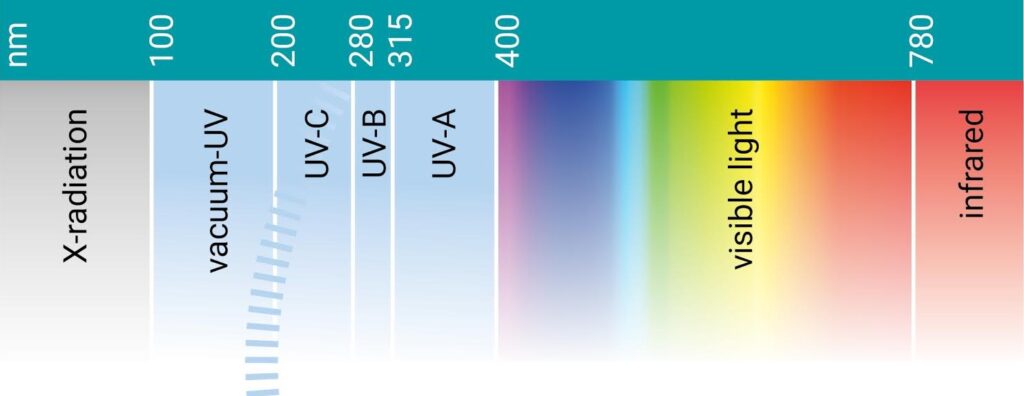The light visible to the human eye is in the range 400-780 nm and higher than UV light which is in the range 100-400 nm.
The answer is: No, you cannot see UVC light.
But how do you check the UV lamp?
Light is defined in nanometers (nm). Below you can see the division of the different areas.
The UV spectrum is from 100-400 nm and is divided into 4 areas:
UVA at 320-400 nm
UVB at 280-320 nm
UVC at 200-280 nm
VUV at 100-200 nm
Visible light is in the range 400-780 nm, so you therefore see UV light. When we check whether a UV source delivers the desired light at the right level (dose), we measure it with our advanced measuring equipment. This measuring equipment has a sensor which is calibrated to exactly the wavelength we want to measure, which allows us to verify the level of light in the area.
You cannot see if a UVC lamp emits the correct light, but you can measure it.
But why can you see that the UV lamp is lit?
The most common UVC lamps are low-pressure lamps which emit up to 45% of their energy in a peak of approx. 240-260 nm, while the remaining energy is emitted in waves of up to 450 nm.
You can therefore see the part of power from the lamp which falls in the visible field of over 400 nm. However, this wavelength has no bactericidal effect, and therefore it has no relation to the UVC effect of the lamp.
What makes UVC light effective on viruses, bacteria and fungi is its ability to destroy DNA/RNA in the organism. The effect is strongest at 260 nm. It is this area you try to reach with most low pressure lamps. Read more about germicidal effect and inactivation here
In fact, UVC as a disinfection method is well documented and was described in Danish research in 1903 as a remedy for tuberculosis.
Our standard UVC lamps peak as close to 260 nm as possible. They peaks at 254 nm and have a high energy conversion to UVC – up to 45%. That specific wavelength, 254 nm, is very well documented since most of all the research on UVC is conducted at that wavelength. When we dimension the dose for different tasks, it is done based of the extensive available research and, of course, your requirements for log reduction. Learn more about how we can help and advise you on the optimal solution here

